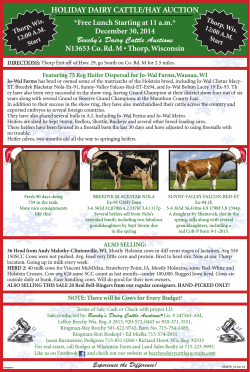
April `15 PRO-DAIRY pages 20, 22
Sponsored by THE MANAGER MAKING MILK By Julie Berry Focus on milk quality A “I use the same approach. I start with the 175-cow dairy in Northern NY significantly A systematic basics,” she said. “Are the milkers doing a good dropped somatic cell count over a two- year job? Are there compounding factors with milking process that included a careful review of the milkreview of the equipment? How are cows being handled? Is the ing system and procedures, the environment and clean and are the cows well-bedded? individual testing of cows. milking system environment It’s finding out where potential exposure is and With somatic cell counts over 400,000 cells/ ml, Twin Mill Farms in Ogdensburg, NY received and procedures doing what you can with that farm.” Regardless of the type of barn or bedding used, a milk quality derogation, which prompted owner and whether a farm uses Dairy Comp or CMT and Blake Gendebien, who is on the board of directors can improve a spread sheet, high levels of milk quality can be for Agri-Mark Inc, to focus on milk quality. quality. achieved, she said. “That made me nervous and forced me to look “You have to gather information and make smart seriously at how we can improve our milk quality,” management decisions. Realize issues are not going to be solved he said. “We’ve hunkered down on milking procedures and have overnight. Be realistic and set goals.” written standard operating procedures. We’re taking it much more At Twin Mills a review of the equipment showed that the vacuum seriously.” was set too high, which was injuring teat ends. A milker training The farm in January 2013 enrolled in Quality Milk Production and milking protocol was implemented. Scillieri Smith also worked Services (QMPS) 400K beat it! program. The farm held six monthly with the herd’s veterinarian to create a treatment protocol. Culture meetings with QMPS, Dairy One, the farm’s veterinarian and the results are used to target and reduce antibioitic use. DHI records are farm’s nutritionist to evaluate biggest risks to the farm and focus reviewed. The entire herd was sampled for culture. on problem solving. The meetings have been so successful that “30 cows were subclinical, which is why the filter sock was Gendebien has continued to meet monthly with Dr. Jessica Scillieri clean. It was confusing everyone. We had a Staph aureus problem,” Smith of QMPS to review DHI records. Gendebien said. “The charts were going up and down. Levels would Dr. Scillieri Smith led the farm through a systematic process, drop, and then the farm had a spike. Somatic cell count dropped as which she said is useful for all farms to problem solve milk quality low as 129,000 in July and then spiked in January.” concerns. Staph aureus is a tricky bacteria because it is contagious, but can also be an environmental pathogen, Scillieri Smith said. Cows can shed intermittently. Scillieri Smith does not recommend eradication as a goal, but management is essential to control effect on the farm. “It was a big hurdle to overcome. It was something we had to do slowly over time,” she said. Dairy comp records are evaluated each month, and chronic and new infections are monitored. The herd is small enough that evaluations are done on a cow-by-cow basis. Staph aureus positive cows are not bred, and are culled when milk production drops. The herd veterinarian conducts fetal sexing, which is used in culling decisions. Milk quality, cow health, income, milk volume and cull cow price are all considered during the culling process. Sometimes one quarter is dried or milk from that quarter is diverted. “There is no cut and dry easy formula,” Scillieri Smith said. “If it costs more money to feed the cow than she is making in milk production, then she is a cull candidate.” “We cultured every single cow and found out which cows had Staph aureus, and then set up parameters on Dairy Comp that Shizuko Maeda, herdswoman, Leah Naplin, veterinarian from included days open, milk production and Staph status, and immeCanton Animal Clinic, and Jessica Scillieri Smith, QMPS, partner on milk quality at Twin Mill Farms. 20 April 2015 DAIRYBUSINESSEAST ■ PRO-DAIRY Continued on page 22 www.dairybusiness.com Sponsored by THE MANAGER harvest but dry matter can change over time due to environmental conditions. Co-Vale Farms checks the dry matters of its feeds three times a week. The ration is adjusted based on this information. Refusals are weighed back daily for each pen and recorded. Feed Tracker is used to monitor the program. Table 1 shows the information that is collected and recorded daily. This information is then entered daily in the farm’s Milk Tracker spreadsheet that tracks the following information on a daily or weekly basis (Table 2). It takes just a minute each morning to input the dry matter intake information. This key piece of information can then be used to monitor other aspects of the dairy. Key to this information being useful is that the people responsible for feeding the cows have the skills and desire to make sure that the details are taken care. At Co-Vale samples are taken correctly and consistently. Scales are checked to make sure they are accurate. Refusals are collected and weighed back. Feeders are trained and comfortable using Feed Tracker. The commitment of the feeder is fundamentally important to achieve feeding accuracy. Improving feeding accuracy allowed Co-Vale Holsteins to take fuller advantage of the ration that was developed to increase pounds of components sold. It also impacts overall cow performance and farm profitability. ❐ Kathy Barrett is a PRO-DAIRY specialist. Email her at kfb3@ cornell.edu. Table 2. Milk Milk Feed Cows Treat Lbs. DM in ed Dry % Date Sold Lbs. Tank Cows Cows BF 7 Day % Milk/ Milk Prot. SCC Bact. Mun AC Avg. ECM DMI FE Milk/cm includes only cows milking, milk/ac includes all cows including treated and dry. FE-feed efficiency Focus on quality continued from page 20 ately culled a number of cows,” Gendebien said. “Fresh cows that responded to treatment were kept. Legs were banded on cows that gave over 90 pounds of milk, but that had cell counts of 200,000 to 400,000. We can make culling choices because beef prices are high. In another year it may have been much harder to make those choices.” In the summer when cows are on pasture, the milking unit is dipped in chlorine, and banded cows are milked last. Positive cows were separated and moved to a barn on his father’s property. Somatic cell ranges from 150,000 to 190,000, butterfat is 3.93 to 4.0% and protein is 3.15 to 3.17% at the home farm. An intern the farm hired from SUNY Cobleskill, Shizuko Maeda, who also has a vet tech degree from SUNY Delhi, and speaks Spanish, English and Japanese, manages the culture sampling, and coordiBlake Gendebien separates Staph aureus positive cows into a separate barn. nates with the farm’s Hispanic milkers. Every month all fresh and clinical mastitis cows are sampled. culture and treat. Sample the entire herd to identify positive cows. “It has been expensive, but at the very least it has been a wash Sample every fresh cow. “We have a lot of room to improve,” with the quality premium,” Gendebien said. Gendebien said. “Our goal for this year is to stay below 200,000.” A herd with lower somatic cell will also likely make more milk, And that, Scillieri Smith says is a smart strategy. Maintaining resulting in unseen increased income, Scillieri Smith said. one goal, for any farm, before trying to further reduce somatic cells Gendebien recommends: Give responsibility to one person to count is realistic. ❐ 22 April 2015 DAIRYBUSINESSEAST ■ PRO-DAIRY 4 November 2014 EASTERNDAIRYBUSINESS ■ PRO-DAIRY www.dairybusiness.com www.dairybusiness.com
© Copyright 2025










